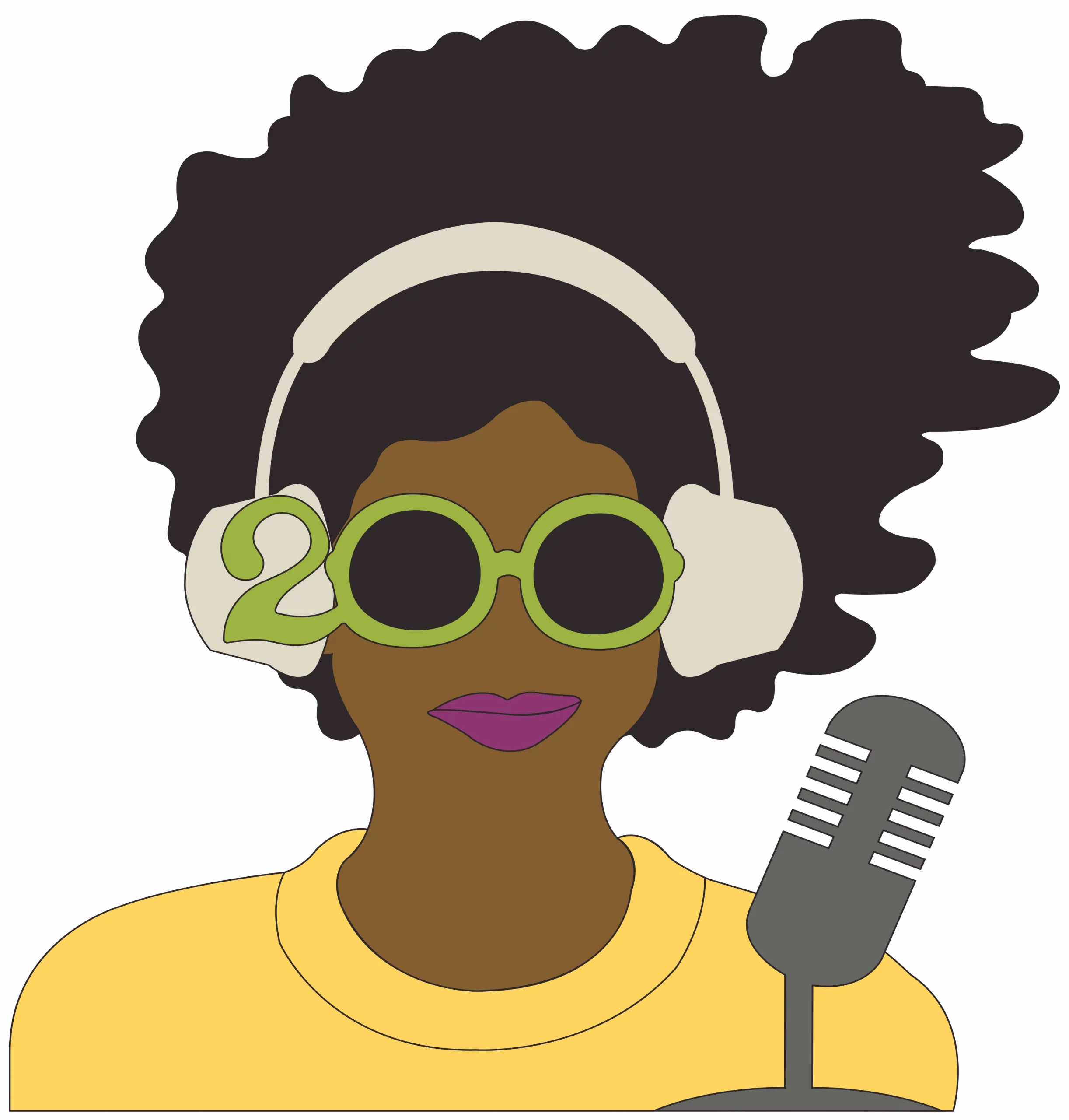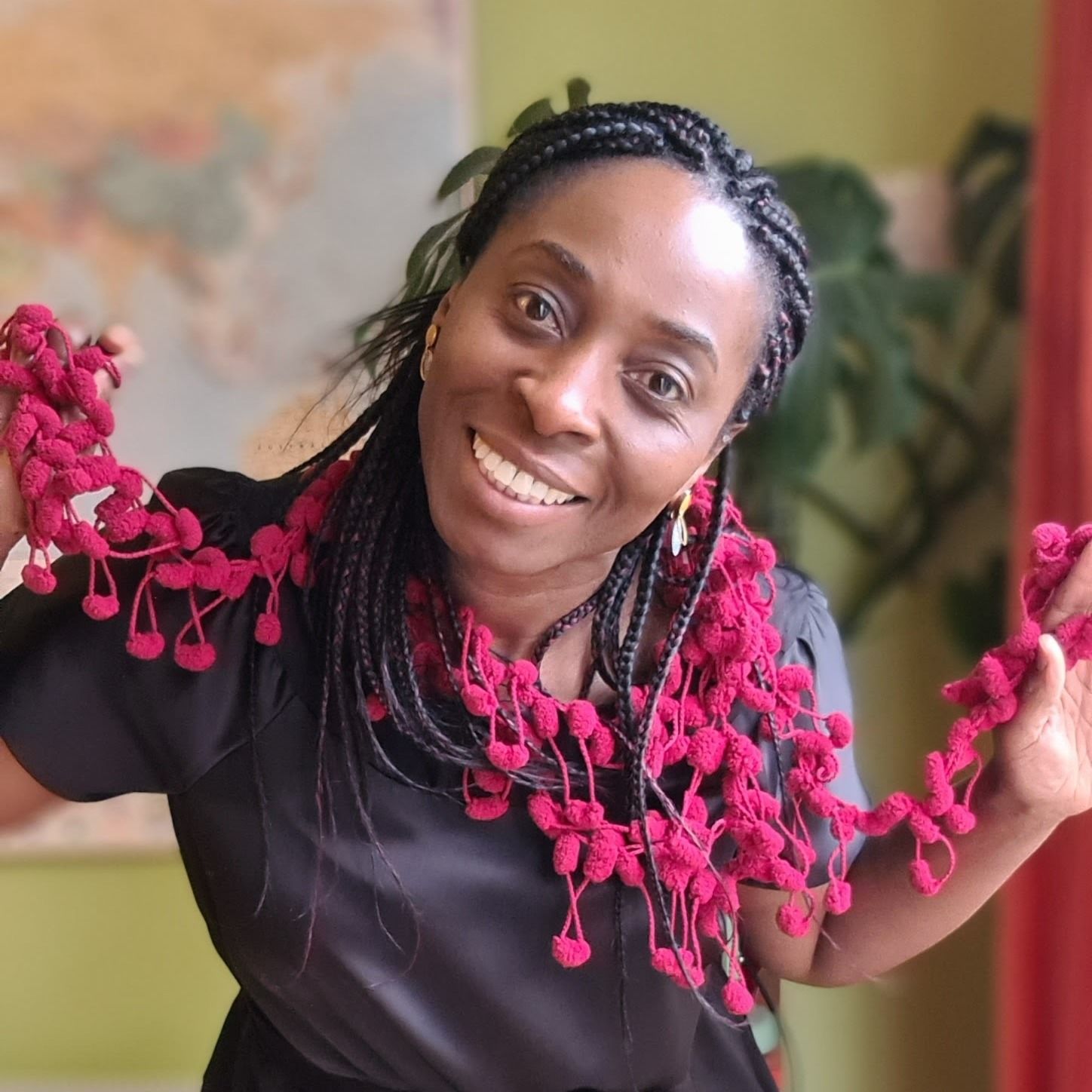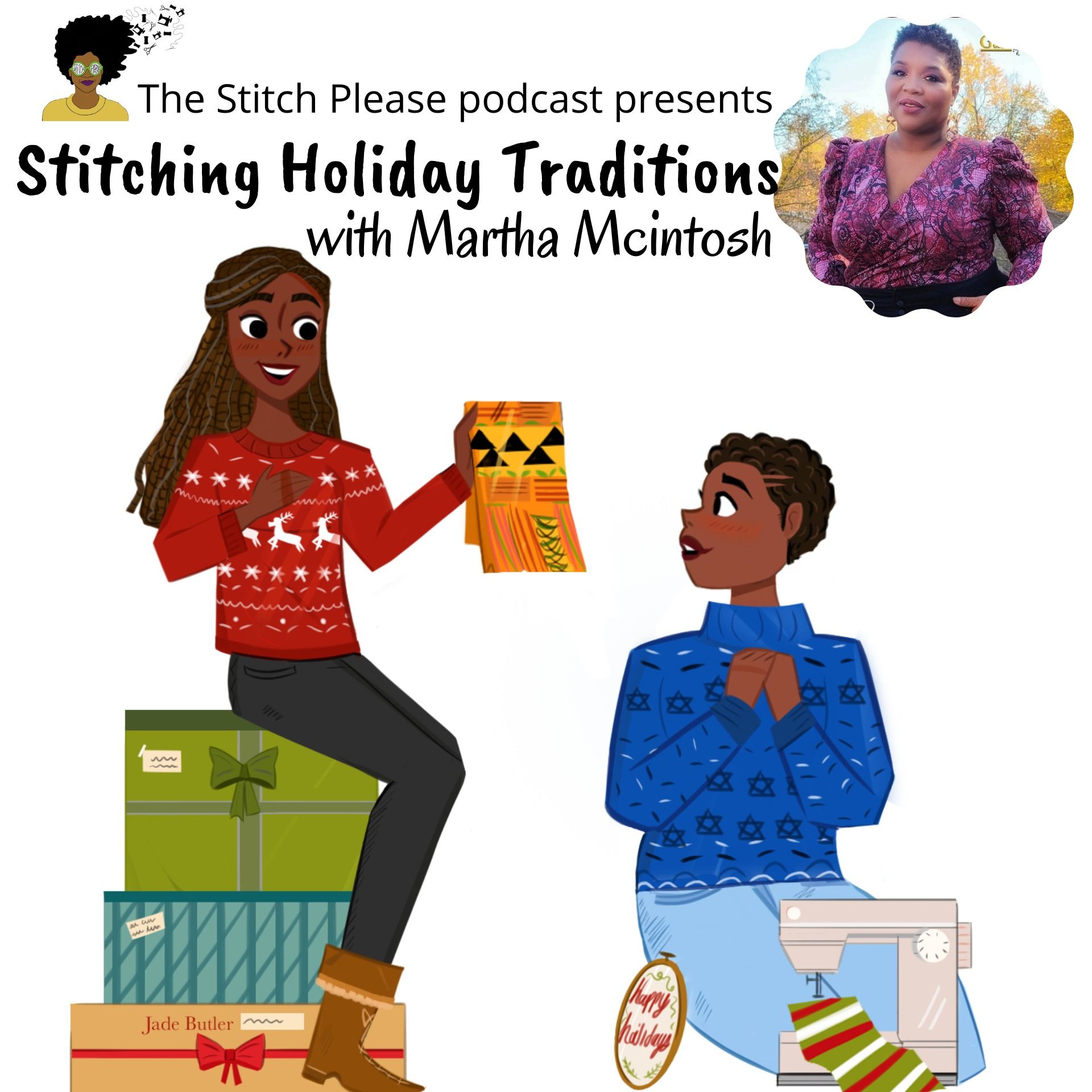Lisa Woolfork 0:12
Hello stitchers. Welcome to Stitch Please. The official podcast of Black Women Stitch, the sewing group where Black lives matter. I'm your host, Lisa Woolfork. I'm a fourth generation sewing enthusiast with more than 20 years of sewing experience. I am looking forward to today's conversation. So sit back, relax, and get ready to get your stitch together.
Hey, friends, Hey, welcome to this Fat Quarter episode. A fat quarter, if you don't know already, is a quarter yard of fabric that has a little bit of junk in the trunk if you know what I mean, a little body yadi yadi. It's designed to be more useful for quilt projects such as applique, or craft projects that requires a more robust piece of fabric. So a fat quarter is a more consolidated version of a traditional quarter yard of fabric. A quarter yard of fabric measures nine inches by 44 inches wide, typically for quilting cards. And that is not particularly useful if you are using paper piecing, for example, as a way to assemble your quilt. So instead of using that long, skinny rectangle, they use a fat quarter. And so this episode is our very first Fat Quarter episode. A fat quarter in the context of Stitch Please means that we are going to help you get your stitch together 18 and 22 minutes or less. That's right. Each Fat Quarter episode will be 18 to 22 minutes or less. So here we go.
Hello, everyone and welcome to the Stitch Please podcast. Today's topic for our Fat Quarter episode is freezer paper. Yes, we are going to talk about sewing with freezer paper. The first thing to know about sewing with freezer paper is identifying freezer paper. Freezer paper is not wax paper. It is not butcher paper. It is not parchment paper. These are all totally different things. But because this is a Fat Quarter episode and I don't have a lot of time, I'm not going to go through and tell you what these things are not. I'm going to tell you what freezer paper is and what it does. Freezer paper is found in the same aisle as the foil and the wax paper and parchment paper and butcher paper. But make sure when you are buying something it says "Freezer Paper." Freezer paper is designed to be used to wrap foods, especially meats, for freezing. Because it is poly coated on one side, it's coated with polyethylene on one side and paper on the other, freezer paper manages moisture better than wax paper. And that's why lots of people use it to preserve meats. That's what it was designed for. But if you look at the package, and the package I'm speaking of is actually photographed in the cover of this episode, the blue long box made by the Reynolds Company. Obviously no endorsements here, but that's what I use because that's what I've seen. I'm not seeing anyone else make freezer paper in the rolls. But freezer paper is designed to help you wrap things up so that they stay fresh in the freezer longer. For example, if you wrap a piece of meat in wax paper in the freezer, it's good for three months. If you wrap it in freezer paper, it's good for a year. Now that takes out all of the things about vacuum seal bags and all of that. We're not talking about vacuum seals. I'm talking about helping people to understand what freezer paper is and I'm being rather adamant about it because I have gotten into so many, maybe arguments is the wrong word. I've gotten into so many conversations with people who don't know what they're talking about, who often try to convince me that freezer paper and parchment paper are the same things when they are absolutely not the same at all. So make sure that you are using freezer paper. I'm going to include links in the end of this episode in the show notes for you to buy freezer paper, the exact kind I use. And for additional clarity, there are two types of freezer paper that I'm going to be talking about. One is the freezer paper on the roll. It's in a long rectangular box just like foil, and another is in sheets, pre cut, eight and a half by 11 sheets of freezer paper that are perfect for running through your printer. And I'm going to explain why that's important right now.
There are lots of ways that you can use freezer paper in your sewing. It shows up, primarily in quilting, freezer paper is known for applique. This has been really helpful. I did a little research and an article by the quilt teacher Pat Sloan talks about how she was doing the research on the history of freezer paper applique. It began around 1979. This is a story that Pat Sloan has found. I'll include the story at the end of the show notes as well. So you can look into this further. There's lots of ways to use it in quilting, but primarily it's been applique. What I find so interesting is that if you look at the Reynolds freezer paper box, you'll see that they actually include one of the purposes, in addition to wrapping meat, is crafts and quilting. This is an exciting thing about freezer paper.
It is a highly functional creative medium, the polyethylene side, the side that is shiny and smooth, is fusible. You can iron that to fabric, especially to cotton fabrics, but I've had success with other fabrics as well. One side is ironable. The other side is smooth. It's for printing, You can write on it, you can run it through a printer. And that's great for patterns. And so I would like to talk to you about how I've used it in apparel sewing as well as quilting and for accessories. I have used freezer paper to help with darts, particularly curved darts. If I have curved darts, or what's called fisheye darts in the back of a garment and say the garment is white, and I don't want to mark anything really dark. I can trace the dart onto the freezer paper, cut it out and fuse it to the inside wrong side of the fabric. Then I make a light outline, either by pressing my tracing wheel really hard on it, or by using a light sketch pencil, like one of the Frixion pens. And then after I've traced it, I can peel away the freezer paper and the outline remains. And that's what I use to pin and stitch the dart. The thing to remember that's really exciting about freezer paper is that you can iron it to fabric many times over without leaving residue behind on your material. This is why folks love it for applique because it's easy to use. It's easy to iron on and it's easy to remove. And it'll do that quite a few times before it starts to lose its stickiness. But because freezer paper is so economical. Like you can get yards and yards and yards of it for not much money and you don't need that much to complete a project. You got something you just keep in your sewing supplies or in your sewing arsenal of tools because it'll last quite a long time. That's one of the things I love about freezer paper for apparel sewing.
The thing I really want us to think about now are patterns, what kind of patterns you can print onto freezer paper and this is where you're going to use a different type of freezer paper than the type that's on the rolls. This is when you're going to want to use the eight and a half by 11 sheets of freezer paper that you can run through your printer. And this is what I love about it; for apparel like for making bras especially bra pieces are not very large. You can get a PDF bra pattern and not have to tape anything really because, regardless of your cup size, the pattern is broken down into pieces that will fit on an eight and a half by eleven sheet of paper. This mean that rather than pinning, which you know I hate to pin things, you can simply run your pattern through the printer. Print on the paper side of the freezer paper and iron that to your fabric. Rather than having to trace it you can iron it on there and cut both the freezer paper and your fabric at the same time, which is going to give you a really nice precise cut. I also like it because it allows you to do some fussy cutting. You can see through the freezer paper just a little bit in order to do some interesting design placement. I love using freezer paper, the eight and a half by 11 sheets of freezer paper for making bras. They're great for making bags and great for making little wallets, all of these things that you could print out on regular printer paper and then figure out how to pin or glue or tape or whatever to get your pattern pieces not to shift when you're cutting them out. And I think this sometimes it can be difficult when, especially if you have special or fine fabrics, but I have had success. myself. I'm not saying this will work for anyone else. But I have had success fusing freezer paper to polyester mesh, to satin and silk, to all sorts of bra and underwear fabric and not have a negative outcome or any type of residue on any of the garments that I made. So anything that makes cutting out little pieces easier is something that I love to do. And freezer paper makes that very easy.
I want to wrap up today's episode by talking about the applique purposes of freezer paper. And I'm really excited because Rashida Coleman Hale has released her Hey Ladies collection as embroidery files, and I am so excited. I love the Hey Ladies. I love that they are Black women. I love that the silhouettes are so gorgeous and beautiful and lively. And when I bought the pattern, I saw that there's about 20 pages of templates for these amazing machine embroidery designs. And I have every intention of printing them out on freezer paper and cutting them out to have for the fabric placement for the embroidery design. And I'll talk about it on Patreon. I will do a little demo video and if you are a Patreon supporter, you get to see the video of me working with printed freezer paper and Rashida Coleman Hale's amazing new designs. And that can give you another idea about how you can use freezer paper in your own sewing and quilting. I will put a link to the designs in the show notes of this episode. So you can see that, but do check out the Patreon. If you are a Black Women Stitch patron, you will see a video showing exactly how I do this so that you can do it too. That's all that we have for today's Fat Quarter episode.
This is about freezer paper, the wonderful freezer paper that comes in the blue box or in eight and a half by 11 sheets. I'm going to include all the links in the show notes, but I want you to give freezer paper a try. If it's something that interests you, and if you have an inkjet printer, be sure it's an inkjet printer. I believe that laser printers are too hot to run freezer paper through. So do check the manufacturer's instructions on any freezer paper that you buy about if it can go through your printer or not. The stuff I have is made exactly for printers but I believe it's made for inkjet ones but the drum of a laser printer does get hot like an iron so you don't want to heat it before it's time.
Thank you so much for tuning into this Fat Quarter episode. I hope you've enjoyed it. I hope you've learned something. And if you're a Patreon subscriber, you will see a video of me talking about freezer paper and working with it in some really cool designs. I'm looking forward to this type of practice with the applique. And using applique techniques alongside machine embroidery . Rashida's designs are a wonderful opportunity to do that. Look in the show notes and see what products I have available there. And this is the exact stuff that I use and so if you do buy it from the links that I have included, is part of the Black Women Stitch Amazon affiliateship, and so if you buy something I think Amazon gives us half a penny.
Thank you all so much for listening to this Fat Quarter episode where we help you get your stitch together in between 18 and 22 minutes or less. Come back next week for some more fun episodes and check out the Patreon for the videos. Take care. You've been listening to the Stitch Please podcast, the official podcast of Black Women Stitch, the sewing group where Black lives matter. We appreciate you supporting us by listening to the podcast. If you'd like to reach out to us with questions, you can contact us at blackwomenstitch@gmail.com. If you'd like to support us financially, you can do that by supporting us on Patreon, P A T R E O N. And you can find Black Woman Stitch there in the Patreon directory. And for as little as $2 a month you can help support the project with things like editing transcripts, and other things to strengthen the podcast. And finally, if financial support is not something you can do right now, you can really help the podcast by rating it and reviewing it anywhere you listen to podcasts that allows you to review them. So I know that not all podcast directories or services allow for reviews, but for those who do, for those that have a star rating or ask for a few comments, if you could share those comments and say nice things about us at the Stitch Please podcast, that is incredibly helpful. Thank you so much. Come back next week and we'll help you get your stitch together.




